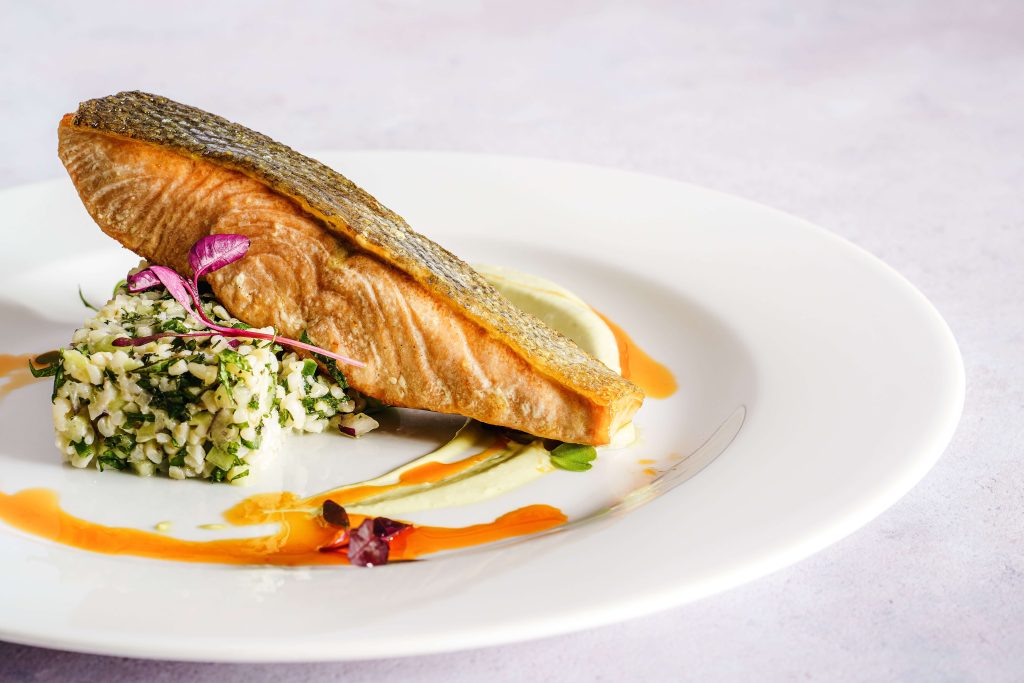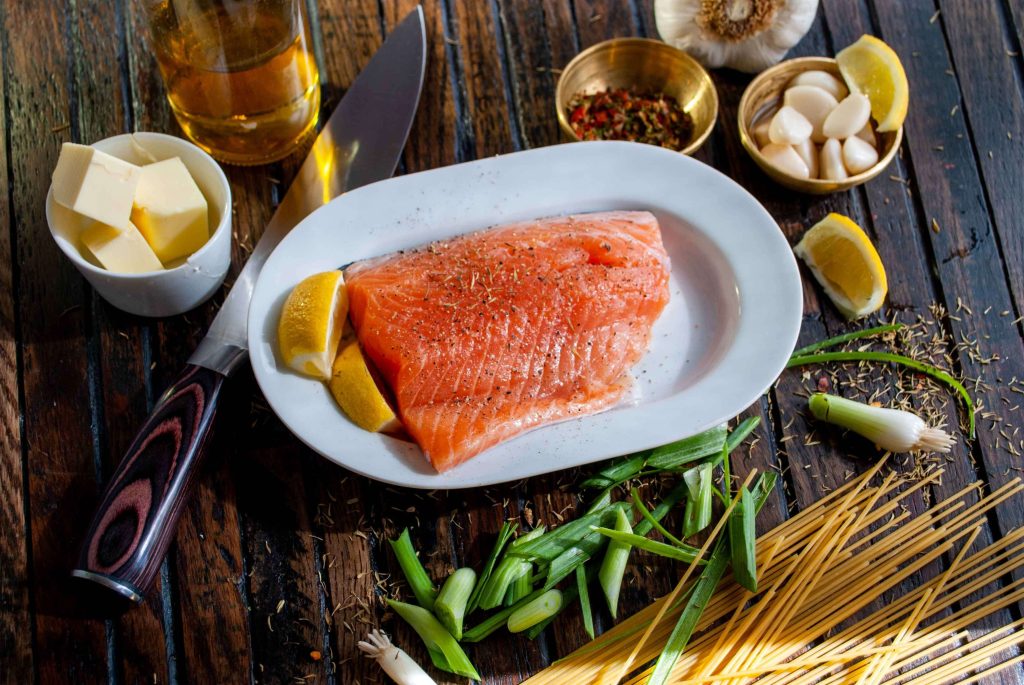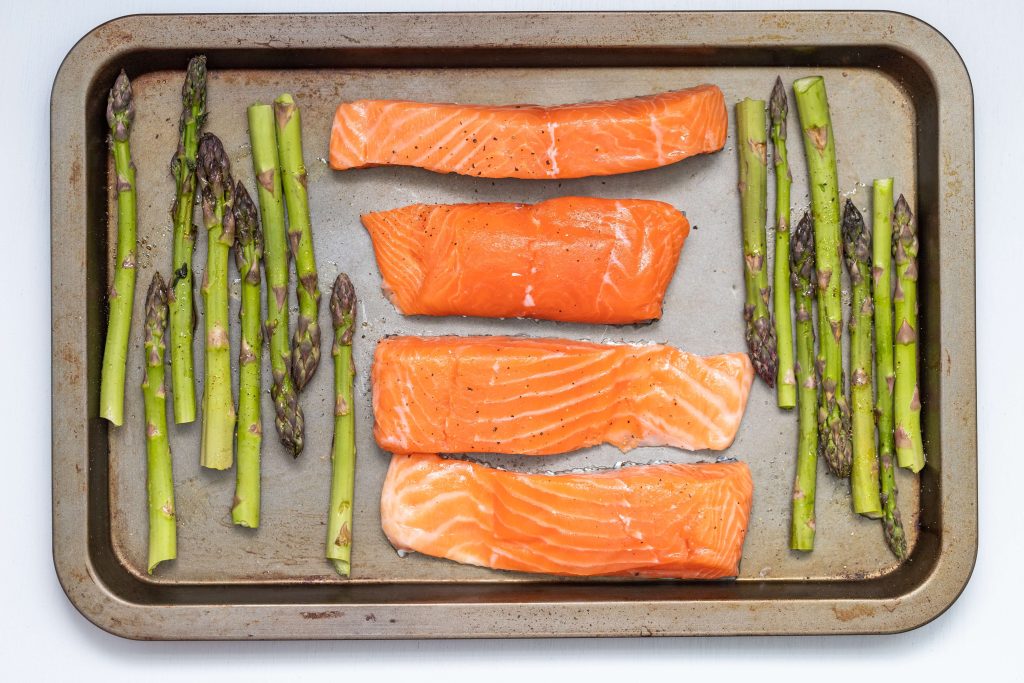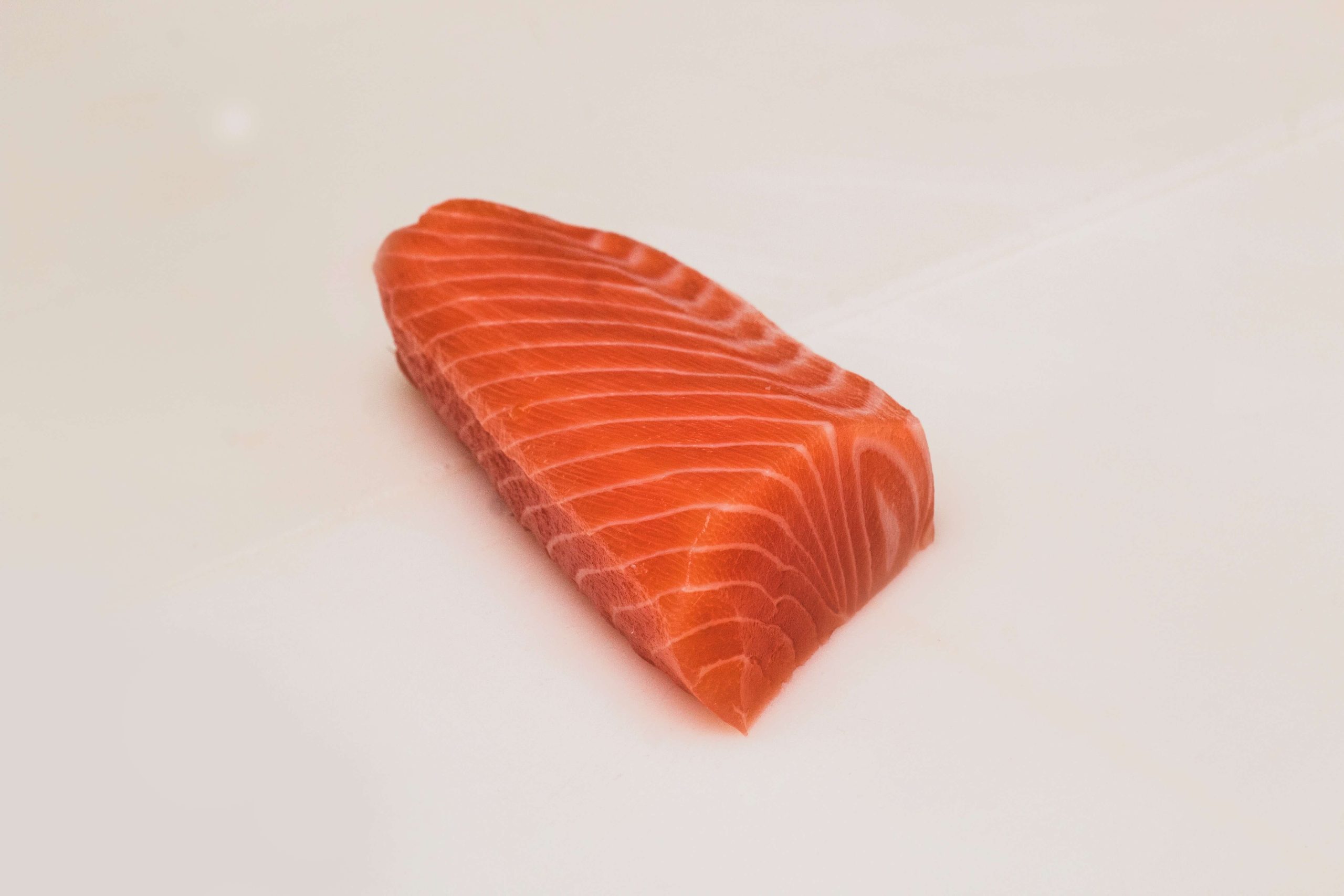Salmon is an incredibly nutritious and tasty fish that can be enjoyed in a variety of ways – baked, grilled, or smoked to name a few. However, as with any food, it’s important to take into account food safety guidelines to avoid getting sick.
- Facts About Salmon You Should Know
- Food Safety Guidelines for Salmon
- Temperature
- Storage
- The 2 Hour Rule
- Why It’s Important to Store Salmon Properly
- How Long Can Fresh Salmon Sit Out?
- How to Tell if Salmon Has Gone Bad
- Can You Eat Cooked Salmon That’s Been Left out?
- Proper Storage of Fresh Salmon
- Use Proper Reheating Techniques
- Keep an Eye on the Temperature
- Consider Adding Moisture
- Don’t Reheat Salmon Twice
- Best Practices for Handling and Preparing Salmon
So, how long can salmon sit out? The answer depends on a few factors. If the salmon is cooked and has been sitting out at room temperature, it should not be left out for more than two hours. This is because bacteria can grow rapidly on cooked salmon at temperatures between 40°F – 140°F (4°C – 60°C).
| Temperature | Maximum Time |
|---|---|
| Room temperature | 2 hours |
| Refrigerator | 1-2 days |
| Freezer | Up to 3 months |
Facts About Salmon You Should Know
Salmon is a popular fish that is widely consumed all over the world. It is a rich source of protein, omega-3 fatty acids, and various essential nutrients. However, it’s important to know some key facts about salmon that can help ensure that you are buying and storing it properly.
Freshness Matters
With salmon freshness is a key, always. Fresh salmon should have a bright, shiny appearance with firm flesh and a mild smell. If you notice any discoloration, slime, or strong odor, it might indicate that the fish is no longer fresh.
Storage Time
If you’re planning to store your salmon, it’s important to keep it at the right temperature. Raw salmon should be refrigerated at 40°F or below and should be consumed within 1-2 days of purchase. Cooked salmon can be stored in the refrigerator for up to 3-4 days. Also take a look at How To Make Potatoes Waffles Vegan if you’re into vegan options.
Freezing Salmon
Freezing salmon is a great way to extend its shelf life. You can freeze raw or cooked salmon for up to 3 months. It’s essential to wrap the salmon tightly to prevent freezer burn.
Cooking Temperatures
When cooking salmon, it’s essential to ensure that it reaches a safe temperature to kill any potential bacteria. The USDA recommends cooking salmon to an internal temperature of 165°F. Investing in a meat thermometer will help you ensure that your salmon is cooked to a safe temperature.

Consuming Raw Salmon
Sushi lovers may enjoy their salmon raw, it’s not recommended to consume raw salmon outside of a reputable restaurant. Raw salmon can potentially contain harmful bacteria or parasites that can cause food poisoning.
Ensuring the freshness of salmon, storing it at the right temperature, cooking it to a safe temperature, freezing it properly, and being cautious of consuming raw salmon are crucial facts you should keep in mind when handling and consuming salmon.
Food Safety Guidelines for Salmon
If you’re wondering how long can salmon sit out, there are a few important guidelines you should follow to ensure the safety of your food.
Temperature
Salmon should be stored at or below 40°F (4°C) to prevent bacterial growth. If the temperature rises above this point, the bacteria associated with spoilage and foodborne illnesses can multiply rapidly.
It is recommended that you store salmon in the refrigerator immediately after purchasing it from the store. If you are not planning to cook the salmon within a day or two, you should freeze it.
While cooking salmon, it is important to ensure that it reaches an internal temperature of 145°F (63°C) before serving.
Storage
Salmon should be stored in an airtight container or wrapped tightly in plastic wrap to prevent air and moisture from getting in. This will help to prevent spoilage and bacterial growth.
If you are storing leftover cooked salmon, make sure it is stored in the refrigerator within two hours of cooking. It can be kept in the refrigerator for up to four days, or frozen for up to four months.
The 2 Hour Rule
The “2 Hour Rule” is a general guideline for the safe handling of perishable foods. According to this rule, any perishable food that has been at room temperature for more than two hours should be discarded.
If you have cooked salmon that has been sitting out at room temperature for more than two hours, it is not safe to consume and should be thrown away. Check also How Many Carbs In Cream Of Broccoli Soup, if you want to take a break after a salmon.
By following these food safety guidelines, you can ensure that your salmon is safe to eat and reduce the risk of food poisoning.
Why It’s Important to Store Salmon Properly
As an avid seafood lover, I can understand the temptation to leave your leftover salmon sitting out on the counter overnight. However, this is not a wise practice as it can pose serious health risks. Here are a few key reasons why it’s crucial to store salmon properly:
- Prevention of bacterial growth: Salmon, like any other raw seafood, is a breeding ground for bacteria. Without proper storage, harmful bacteria such as salmonella and listeria can grow rapidly and cause foodborne illnesses. One of the main ways to prevent bacterial growth on salmon is to keep it refrigerated at temperatures below 40°F.
- Preservation of freshness: Storing salmon at the right temperature is crucial not only for safety reasons but also for preserving its optimal freshness. If salmon is left at room temperature for too long, it can start to develop a “fishy” odor and taste that can be unpleasant.
- Avoidance of food waste: Properly storing salmon can also help you avoid wasting food. If you leave cooked salmon at room temperature for too long, it can spoil and become unsafe to eat. This means you’ll need to throw it away, wasting both food and money.
Taking the time to store your salmon properly is well worth the effort to ensure your safety, preserve freshness, and avoid wasting food. When in doubt, it’s always better to err on the side of caution and store your salmon in the refrigerator.
How Long Can Fresh Salmon Sit Out?
As an expert in the culinary world, I often get asked about the shelf life of various foods. One question I get asked often is how long fresh salmon can sit out before spoiling. The answer to this question depends on a number of factors, such as the temperature and humidity of the room the salmon is sitting in and how fresh the salmon actually is.
In general, it is best to refrigerate fresh salmon as soon as possible after you have purchased it. Fresh salmon has a relatively short shelf life, and if it is not stored properly it can spoil quickly. If you are buying fresh salmon from a grocery store, ask if they have any salmon that has been stored on ice or in a refrigerator. This may help to extend the shelf life of the fish.

If you have already brought fresh salmon home and need to know how long it can sit out, the answer is about 2 hours at room temperature. However, this time may vary depending on the conditions of the room that the fish is sitting in. If the room is cool and dry, the salmon may be able to sit out for slightly longer without spoiling.
It is important to keep in mind that if the salmon has been sitting out for more than 2 hours, it is best to err on the side of caution and dispose of it. Eating spoiled salmon can cause food poisoning and other illnesses, so it’s better to be safe than sorry.
To help extend the shelf life of fresh salmon, consider storing it in an airtight container in the refrigerator, or freezer if you won’t be eating it for an extended period of time. Be sure to use it within a day or two if you have stored it in the refrigerator, or within three months if you have frozen it.
So… fresh salmon can sit out at room temperature for about 2 hours, but it’s best to refrigerate it as soon as possible. Remember to always be mindful of food safety and take necessary precautions to prevent foodborne illnesses.
How to Tell if Salmon Has Gone Bad
As an expert in seafood, I know how important it is to properly store and handle salmon to prevent it from going bad. However, even with proper storage, salmon can still spoil if it has been sitting out for too long. Here are a few ways to tell if your salmon has gone bad:
- Smell: One of the easiest ways to tell if salmon has gone bad is to give it a sniff. Fresh salmon should have a mild sea-like scent – almost like cucumber. If your salmon smells sour, pungent, or fishy, it’s probably gone bad.
- Color: Fresh salmon should be bright, shiny, and have a uniform color. If your salmon is discolored, has a dull appearance, or has brown spots, it may have gone bad.
- Texture: Fresh salmon should have a firm and elastic texture. If your salmon feels slimy, mushy, or has a sticky texture, it may have gone bad.
- Date: Always check the use-by or sell-by date on the salmon packaging before purchasing and cooking it. If the date has passed, it’s best to avoid purchasing and consuming it.
- Bacteria: Salmon can contain harmful bacteria such as E.coli and Salmonella. If you have any concerns about the freshness of your salmon, it’s best to throw it away and avoid the risk of food poisoning.
Remember, it’s always better to be safe than sorry when it comes to consuming seafood. If your salmon looks or smells questionable, it’s best to avoid consuming it and opt for fresh salmon instead.
Can You Eat Cooked Salmon That’s Been Left out?
For cooked salmon, the rule of thumb is that it should never be left out for more than two hours. After two hours, bacteria starts to grow at a rapid pace, increasing the risk of food poisoning.
According to the United States Department of Agriculture (USDA), cooked salmon that has been left out for more than two hours at room temperature should be discarded. This is because bacteria that cause foodborne illnesses can grow at temperatures between 40°F and 140°F.

It’s important to note that the two-hour rule applies to cooked salmon that has been left out at room temperature. If the temperature is above 90°F, the safe time for leaving out cooked salmon is only 1 hour. If the cooked salmon has been left out in a warm environment for an extended period, it’s best to err on the side of caution and discard it.
One exception to the two-hour rule is if the salmon has been kept at a temperature of 32°F to 40°F, either in the refrigerator or on ice. In this case, the cooked salmon can be safely consumed within three to four days. However, it’s important to check the salmon for any signs of spoilage, such as a sour smell or slimy texture, before eating it.
Also it’s best to be cautious with cooked salmon that has been left out. Always use the two-hour rule as a guide and if in doubt, discard the food to avoid the risk of food poisoning. Remember to keep cooked salmon refrigerated at 32°F to 40°F if you plan on consuming it beyond a few hours.
Proper Storage of Fresh Salmon
Properly storing fresh salmon is essential to prolong its shelf life and maintain its quality. Here are some tips to ensure that your salmon is stored correctly:
- Refrigeration is key: Fresh salmon should always be kept in the refrigerator at a temperature of 40°F or below. This includes during transportation and while waiting to be cooked. Make sure to put your salmon in the refrigerator as soon as possible after purchasing it.
- Use it in a timely manner: Fresh salmon is best when consumed within two days of purchase. Make sure to plan your meals accordingly to avoid letting the salmon sit in the refrigerator for too long.
- Don’t skimp on packaging: When purchasing fresh salmon, ensure that it is well-packaged and sealed. This will help prevent exposure to air and potential contaminants.
- Avoid freezing if possible: While fresh salmon can be frozen, it is best consumed fresh. If you do need to freeze your salmon, make sure to properly wrap it and date it before freezing. Frozen salmon can last up to six months in the freezer.
- Handle with care: When handling fresh salmon, make sure to wash your hands thoroughly before and after handling it. Avoid cross-contamination with other foods by using separate cutting boards and utensils.
By following these guidelines, you can ensure that your fresh salmon is stored correctly and is safe to consume. Proper storage not only extends the shelf life of your salmon, but it also maintains its quality and flavor.
With reheating previously cooked salmon, there are a few things to keep in mind to ensure that it stays safe to eat and maintains its flavor and texture. Here’s what I recommend:
Use Proper Reheating Techniques
There are a few ways to reheat salmon, but some methods are better than others. The best methods are those that will heat the salmon quickly and evenly without drying it out or making it tough. Here are a few options:
- Oven: Preheat your oven to 275°F and place the salmon on a baking sheet. Cover it loosely with foil, and bake for about 15 minutes or until it reaches an internal temperature of 145°F.
- Microwave: Place the salmon in a microwave-safe dish and cover it with a damp paper towel. Microwave on high for 30-second intervals until the salmon is heated through.
- Stovetop: Place the salmon in a pan with a little bit of oil or butter and heat it over medium heat, flipping it occasionally, until it’s warmed through.
Keep an Eye on the Temperature
It’s crucial to make sure that the salmon reaches an internal temperature of 145°F before it’s safe to eat. You can use a meat thermometer to check the temperature of the salmon in the thickest part, but make sure to avoid touching any bones as they can be hotter than the flesh.
Consider Adding Moisture
If you’re worried about the salmon drying out during the reheating process, you can try adding some moisture to the dish. This can be done by drizzling a little bit of olive oil, lemon juice, or white wine on top of the salmon or by placing a moist paper towel over it while it reheats. Be careful not to add too much moisture, as this can cause the salmon to become waterlogged.
Don’t Reheat Salmon Twice
It’s best to reheat salmon only once to reduce the risk of bacterial growth and maintain its flavor. If you have leftovers after reheating, store them in an airtight container in the refrigerator and eat within a day or two.
By following these tips, you can safely and effectively reheat your previously cooked salmon to enjoy it again without compromising on taste or texture.
Best Practices for Handling and Preparing Salmon
As a seafood lover and avid cook, I always make sure to follow best practices when handling and preparing salmon to ensure its safety and quality. Here are some tips that I recommend following:
- Always purchase salmon from a reputable source that has strict quality controls, and ensure that it’s fresh and properly stored. Look for salmon that has bright, firm, and moist flesh with a mild sea odor. Avoid any salmon that has a strong odor, discolored spots, or dry patches.
- Store salmon in the refrigerator immediately after purchasing it, and consume it within 1-2 days. If you can’t consume it within this timeframe, freeze it. When freezing, wrap the salmon tightly in plastic wrap or aluminum foil, label it with the date, and place it in the freezer for up to 3 months.
- Thaw frozen salmon in the refrigerator overnight or under cold running water. Never thaw salmon at room temperature or in warm water, as this can promote bacterial growth.
- When preparing salmon, always wash your hands and sanitize all surfaces and utensils that will come into contact with the fish to prevent cross-contamination. Use separate utensils and cutting boards for raw and cooked salmon, and never reuse marinades or sauces that have come into contact with raw salmon.
- Cook salmon to an internal temperature of 145°F (63°C) to kill any harmful bacteria. You can use a food thermometer to ensure that the salmon is fully cooked. Avoid eating undercooked or raw salmon, which can contain parasites and other harmful pathogens.
By following these best practices, you can enjoy delicious and safe salmon dishes that are sure to impress.
Happy cooking!

